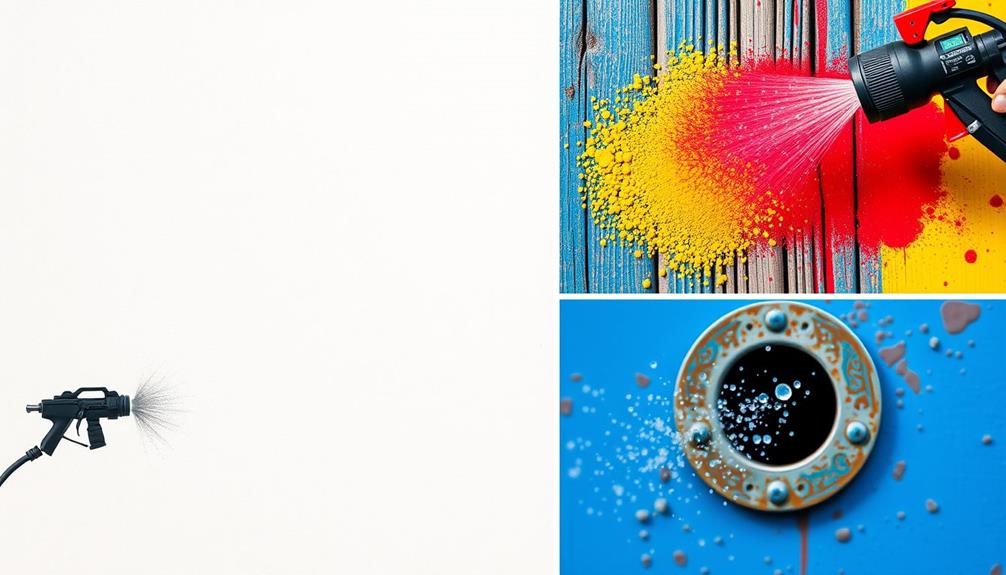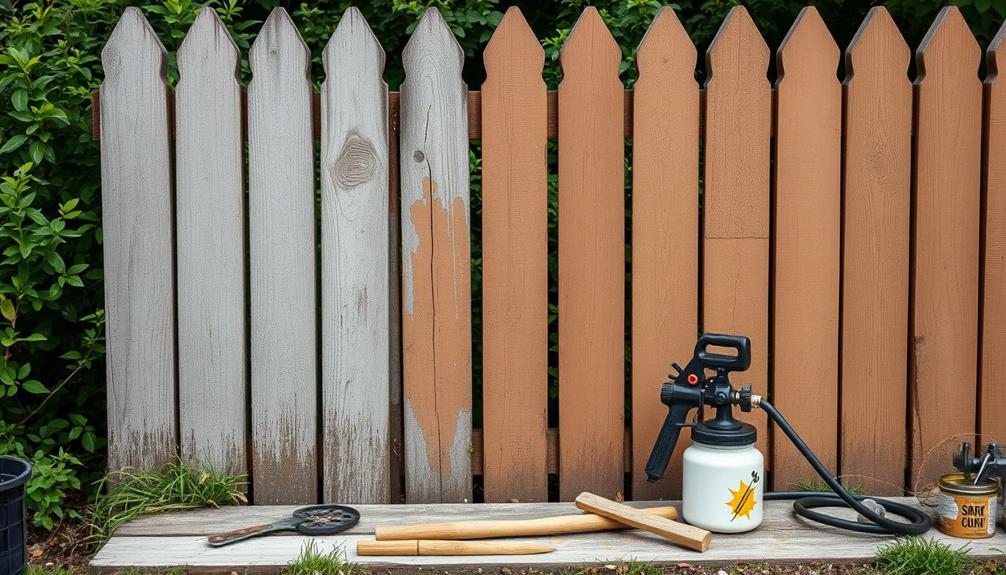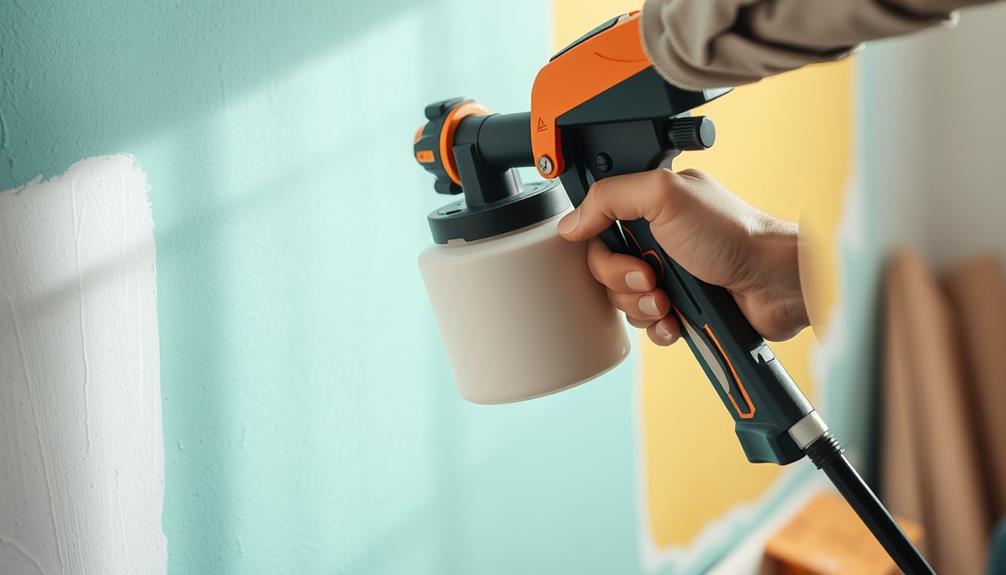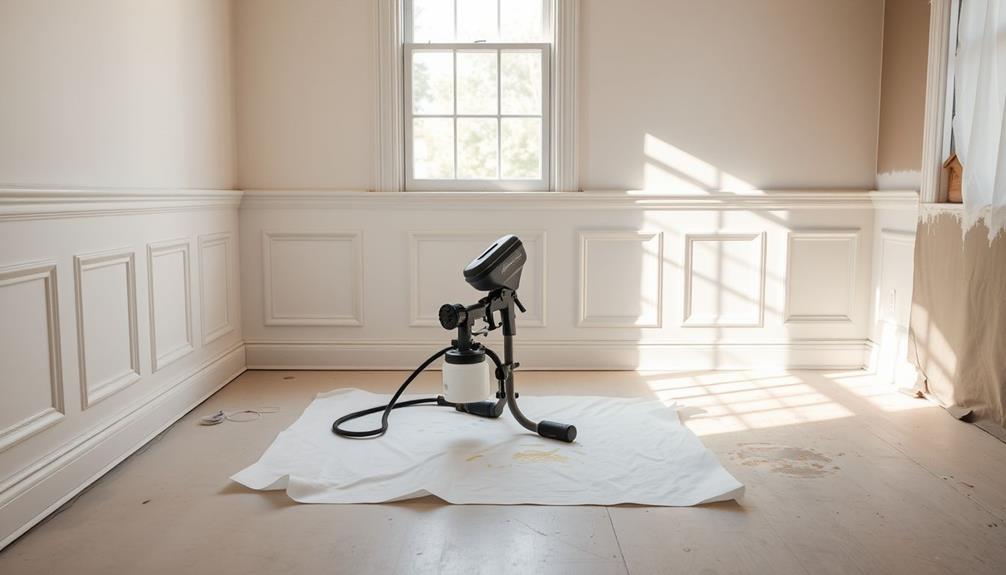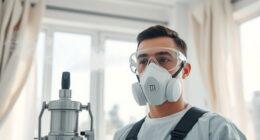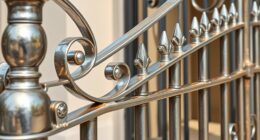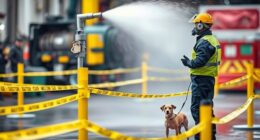To achieve a professional finish with an airless paint sprayer, start by gathering your tools and preparing the area. Choose the right spray tip and adjust the pressure for best results. Keep a consistent distance of about 12 inches from the surface and maintain the gun perpendicular to it. Overlap each pass by 50% to guarantee even coverage, and remember to trigger the gun only while in motion to prevent drips. Regularly clean filters and tips to avoid clogs. Master these techniques, and you'll be well on your way to a flawless finish that impresses. More tips await you for success.
Key Takeaways
- Prepare surfaces thoroughly by cleaning, filling holes, and taping edges to ensure a smooth and flawless finish.
- Choose the right spray tip size and pressure setting to optimize paint flow and achieve an even coat.
- Maintain a consistent distance of about 12 inches from the surface to prevent uneven coverage and drips.
- Overlap each pass by 50% to ensure complete coverage and a uniform finish across the entire area.
- Regularly clean filters and spray tips to avoid clogs and maintain optimal performance throughout the project.
Understanding Airless Paint Sprayers
Airless paint sprayers revolutionize the painting process by pressurizing paint up to 3,000 psi, creating a fine mist that allows you to cover surfaces quickly and efficiently.
These powerful tools use pressure to atomize the paint, which means you can apply it directly from containers without needing compressed air. This feature makes airless sprayers versatile, as they can handle a wide variety of materials, from water-based paints to high viscosity products.
Additionally, best practices for choosing the right sprayer can enhance your overall experience.
One key aspect of using an airless paint sprayer is understanding the spray tip. By adjusting the tip size, you can change the spray pattern and flow rate, allowing for precise control over your application.
This flexibility enables you to achieve even coverage, especially on textured surfaces or when working with dark colors. With airless sprayers, you'll find that you often need fewer coats than with traditional methods, saving time and effort.
To guarantee peak performance, regular maintenance is vital. Check the spray tips and filters frequently, and keep the equipment clean to prevent clogs and uneven spray patterns.
Preparing for Your Project

Before diving into your painting project, it's vital to prepare your work area properly to guarantee a smooth and efficient process. Start by gathering all the necessary tools and materials, including your airless sprayer, painter's tape, plastic sheeting, and protective gear. This preparation prevents chaos and assures you have everything on hand.
Additionally, consider the type of paint you'll be using, as dilution guidelines can greatly affect sprayability and finish quality.
Next, clear the area by removing furniture and covering the floors. Tape off edges to protect surfaces from paint splatter, which helps in achieving clean lines.
Don't forget to clean and inspect the surface you'll be painting, filling any holes or imperfections to guarantee a flawless finish.
Choosing the right spray tip size and pressure setting is vital for your project. These factors greatly influence the spray pattern and coverage, contributing to an even coat.
To get comfortable with your equipment, practice your spray technique in a safe area, like a garage door, using water. This step allows you to familiarize yourself with the sprayer and make any necessary adjustments before starting your actual project.
Always prioritize safety precautions to create a safe working environment.
Techniques for Effective Spraying

When you're ready to start spraying, mastering effective techniques can make all the difference in achieving a professional finish. The right approach guarantees you get even coverage without the hassle of runs or sags.
First, maintain a consistent distance of about 12 inches from the surface. This keeps your spray gun at peak performance and helps prevent overspray. Always keep your spray gun perpendicular to the surface; avoid fanning to create a uniform spray pattern.
Overlap each pass by 50% to fill in any missed spots, leading to a smoother finish. Trigger the gun only while in motion to avoid drips and uneven surfaces. Finally, aim into corners and edges to guarantee every area receives adequate coverage.
| Technique | Benefit |
|---|---|
| Consistent Distance | Guarantees even coverage |
| Perpendicular Positioning | Minimizes overspray |
| 50% Overlap | Completes coverage |
| Trigger in Motion | Prevents drips |
Common Challenges and Solutions

Using an airless paint sprayer can be a game changer, but it also brings its own set of challenges that can frustrate even experienced users. One common issue is clogged filters or spray tips, which you can avoid by performing regular maintenance and cleaning your sprayer thoroughly after each use.
Additionally, make sure to properly prime the pump before starting; failing to do so can lead to paint splatter and uneven spray patterns. It's also helpful to take into account key factors in choosing a home cleaning service if you need assistance with cleanup after your painting project.
Another challenge arises from incorrect pressure settings. Over or under-adjusting these settings can create poor spray patterns. To find the sweet spot, test on cardboard before applying paint to your project.
Maintaining a consistent distance from the surface—ideally around 12 inches—is essential for avoiding uneven coverage, which can detract from that professional finish you're aiming for.
Lastly, if your paint doesn't adhere well, check the spray tip size and replace any worn tips. Addressing these common challenges can greatly improve your results and help you achieve that flawless look you desire.
Recommended Tools and Materials

To achieve a professional finish with your airless paint sprayer, you'll need a few essential tools and materials on hand. First, make sure you have the airless sprayer itself, along with a bucket for paint.
Don't forget a mesh filter bag; it'll help prevent clogging during your spray application, ensuring a smooth flow of paint. Additionally, consider the importance of safeguarding your home, as a well-maintained environment can enhance your painting experience home security benefits.
Protective equipment is vital for your safety, so equip yourself with safety glasses and an approved respirator mask. These will protect you from harmful paint fumes and particles.
Additionally, using protective gloves will keep your hands clean and safe from paint exposure.
Painter's tape is indispensable for masking off areas you don't want to paint, while plastic sheeting can safeguard surfaces like floors and furniture from accidental splatters.
If you're covering larger areas, butcher paper works well for that purpose too.
Frequently Asked Questions
How Do You Get a Smooth Finish With an Airless Sprayer?
To get a smooth finish with an airless sprayer, maintain a consistent distance, use the right tip size, adjust pressure, overlap passes, and practice on a test surface. You'll see improvement in your results.
Do Airless Sprayers Give a Better Finish?
When it comes to painting, airless sprayers really hit the nail on the head. You'll find they deliver a smoother, more uniform finish than brushes or rollers, making your project look exceptional without the hassle.
What Is the Number One Rule When Using Airless Spray Guns?
The number one rule when using airless spray guns is to maintain a consistent distance of about 12 inches from the surface. This helps you achieve an even application and ideal coverage throughout your project.
How Many Coats Do You Need With an Airless Sprayer?
You typically need one coat with an airless sprayer for good coverage, but two coats are often better for durability and finish. Always let the first coat dry completely before applying the second.
Conclusion
To sum up, using an airless paint sprayer can greatly enhance your painting projects, offering a professional finish that's hard to beat. Did you know that airless sprayers can reduce painting time by up to 40% compared to traditional methods? By mastering the preparation and techniques outlined, you'll not only save time but also achieve a smooth, even coat. So, grab your sprayer and transform your space with ease and efficiency!

